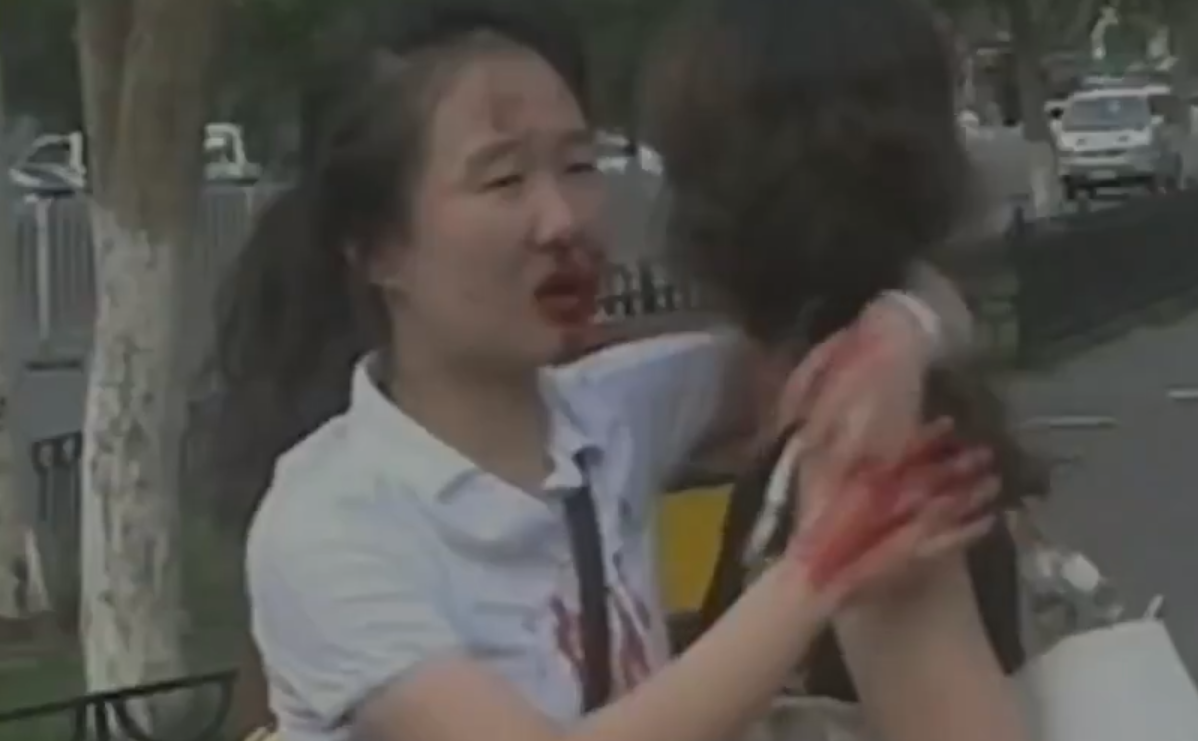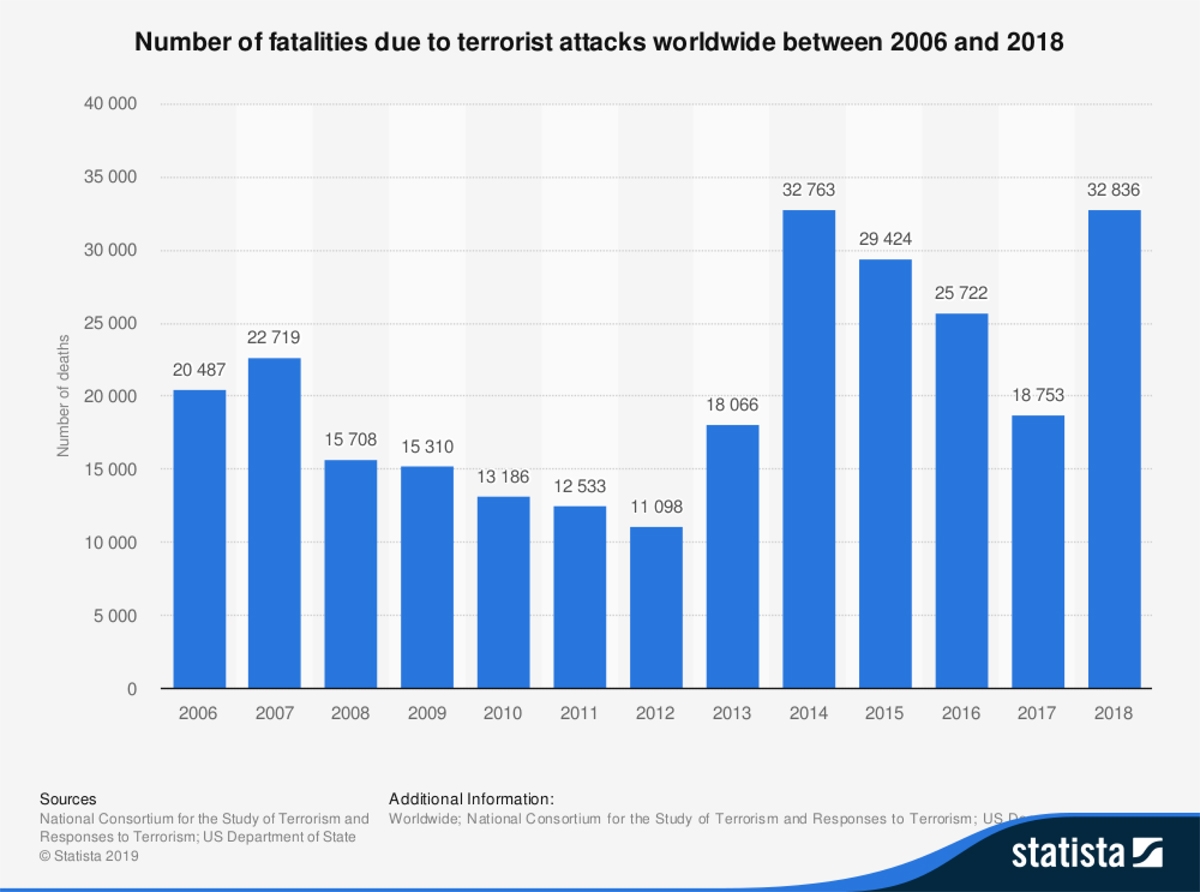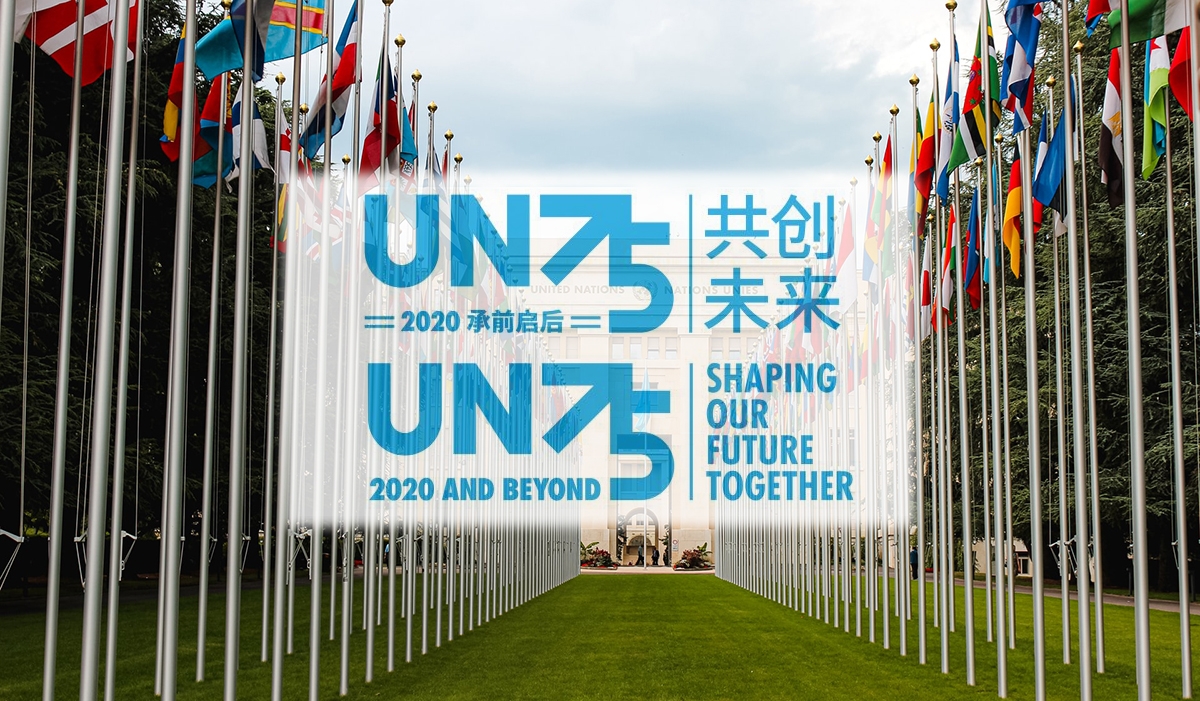
Video shows horror of terrorist attacks against innocent Chinese civilians in Xinjiang — China is fighting terrorism too
Since 9/11, few subjects have shaped the global narrative as much as terrorism. Terrorism is defined as unlawful violence or the systematic use of terror against civilians or politicians for ideological or political reasons, with the intention to create fear. Terrorism is practiced by nationalistic groups, religious groups, revolutionaries and governments and has no borders.
On September 20, 2001, just days following the September 11 attacks in New York, U.S. President George W. Bush declared a ‘War on Terror’ that was the basis for sending America to war with Al-Qaeda.That phrase is now synonymous with American foreign policy in the Middle East, alongside the foreign policy of many of America’s allies.
A report published in November 2019 by Statista Research shows the number of terrorist attacks and deaths due to terrorism worldwide between 2006 and 2018. These attacks have resulted in the deaths of hundreds of innocents over the past fifteen years, whether it a bus bombing in London, gunfire and weapons attacks in Paris and Brussels, the bombing of a train station in Madrid, or lone wolf attacks in Cologne, Nice, Ottawa, and in several U.S. cities. These incidents have kept the terrorism issue front of mind for people around the world.
The data reveals that the overall number of extremist attacks worldwide has declined between 2006 and 2017. In 2006, there were approximately 14,371 terrorist attacks and in 2018 that number was down to 8,093. However, there were still 32,836 innocent people killed as a result of the 2018 attacks.
The Global Terrorism Database (GTD)™ has the most comprehensive unclassified database of terrorist attacks in the world. It is produced by a dedicated team of researchers and technical staff, who are supported by an alumnus of researchers. The governance of the database is assured by an advisory board which includes some of the most respected academics in the field of terrorism research.
The ‘War on Terror’ and subsequent invasion of Iraq led by the United States and several of its allies in March 2003 was met with a parallel response in violent extremism from multiple groups with multiple causes the world over. The GTD™ data indicates that terrorist attacks rose dramatically after 2004, climbing from just over 1,000 that year to almost 17,000 by 2014. More than 70 per cent of the attacks in the past 10 years transpired in just two regions, both of which have seen extensive insurgency and civil conflict during that time: North Africa/Middle East and South-Central Asia.
Interestingly, the research shows that terrorism is dramatically down in countries not suffering from civil wars and insurgencies, and that most terror incidents that have taken place during the global war on terror are linked with insurgencies and civil wars.
Sean Zeigler associate political scientist and Meagan Smith a quantitative analyst at the nonprofit, nonpartisan RAND Corporation study terrorism and found a marked trend reversal in terror attacks (pre- and post-2001) in predominantly Muslim countries. “Before 2001, countries with higher Muslim populations experienced less domestic terrorism, while since 9/11, these countries have seen significantly more – both domestic and international. They note this pattern is particularly strong in places recently affected with conflicts, such as Iraq, Afghanistan, Pakistan, Libya, and Sudan.” Zeigler and Smith believe the findings “may be a result of domestic upheavals in parts of the Muslim world and Islamist groups’ involvement in Arab Spring-related conflicts. Islamist insurgencies have risen since 2001 and an increase in terrorism is likely a byproduct of this fact. They maintain that, “defensive measures in the West have forced a shift in targets. While jihadist terrorism has become more enduring and widespread in the past 15 years, as suggested by the reversal in Muslim-majority countries, it remains more local than global.”

Zeigler and Smith say that interventions by Western countries may be contributing to this pattern of terrorism in Muslim countries. “Unsurprisingly, we found a positive correlation between Western military interventions on behalf of governments fighting civil wars and domestic terrorism in those countries. The models revealed that Western intervention was associated with anywhere from a two to five-fold increase in the expected number of domestic attacks. No doubt, intervening nations only participate in the most protracted and pernicious wars – those most likely to exhibit terrorism in the first place, suggesting that Western interventions may be a symptom of terrorism in these countries as well as a possible cause. In the past decade and a half, this includes multi-sided insurgencies in countries such as Iraq, Afghanistan, Syria, Libya, and Mali.”
A U.S. Congressional Research Service report estimates that through 2014, the global war on terror cost $1.6 trillion to the U.S. government alone for military operations and supporting efforts.
Western populations experience the consequences of the war on terror each day. The obvious markers are the militarization of local police forces, extra and often intrusive security checks at most public events and venues or using surveillance technologies that are placed everywhere from shopping centres to banks to airports and train stations.
The terrorist culture and violent nature of many jihadists knows no borders. Chaos and death and violence are their playbook as they pervert Muslim religious practices and traditions as a methodology to incite violence and propagate mostly young men to join participate in their extremism and carry out violent attacks. How else do you explain how over 100 Canadian, 300 Americans and over 1000 British extremists who were so brainwashed in their misguided cause that they left the civility of their countries to go and fight for the genocidal ISIS abroad and in some cases, brought the terrorist fight back home with them.
Western countries, including Canada have responded to these events and the violence of the jihadi’s with new domestic terrorism laws such as the U.S. Patriot Act, Bill C-51 in Canada, the counter-terrorism and border security bill in Britain and the new “Strengthening Homeland Security and the Fight Against Terrorism” (SILT) law in France. These laws provide governments and their courts, police and security services with new powers directed at blunting terrorists before they act.
Ironically, while Western governments have increased their own surveillance and police capacity and abilities and spent close to two trillion dollars themselves to combat terrorism in Europe and North America in the past 15 years, they have attacked and criticized the Chinese government for its response to counter domestic terrorism and violent jihadi extremists in China’s Western Xinjiang province.
Many American, Canadian and European politicians have accused China of being prejudicial to minority groups, specifically Muslims in Western China and claim they are targeting them under the guise of ‘rooting out terrorists.’
Amnesty International’s 2018 briefing ‘Where Are They?’ accused the Chinese government of having a campaign of mass internment, intrusive surveillance, political indoctrination and forced cultural assimilation against Uyghurs, Kazakhs and other predominantly Muslim ethnic groups living in Xinjiang. The report claimed the internment of predominantly Muslim ethnic groups in Xinjiang has intensified since March 2017, when a “Regulation on De-extremification” was adopted in the region. Open or even private displays of religious and cultural affiliation, including growing an “abnormal” beard, wearing a veil or headscarf, regular prayer, fasting or avoidance of alcohol, or possessing books or articles about Islam or Uyghur culture can be considered “extremist” under the regulation.
The Chinese government have vehemently denied these claims and justified the actions they have taken as necessary to counter what they claim to be ‘terrorism’ and to ensure national security. The rise of terrorism based on extreme religious views by a violent minority has been a challenge in China since 1990.
The Chinese, like the west have found their own way of dealing with terrorism and until recently have not shared the extent of the problems they have been dealing with to combat terrorism in the Xinjiang western region of China from 1990-2016. In response to what they believe to be continuing criticism and misinformation from many Western countries, the Chinese state media have released two videos to the public for the first time that provide significant insight into the harsh violence they have been confronting from domestic terrorists in Xinjiang province.
The videos begin by explaining the heritage and livelihoods and diversity of the more than 30 ethnic groups who make up the Xinjiang region. Then, in chilling detail they show footage that captures many of the violent jihadi attacks on the innocent population that have occurred between 1990 through 2016. The brutality is shocking, heartbreaking and as riveting and upsetting as any of the news coverage that emerged of the Western attacks during the same period that most people watched live on CNN, whether they were in Paris, London, Brussels, Madrid, Nice or Ottawa.
The Chinese government says during this period thousands of terrorist’s attacks were launched in Xinjiang, killing large numbers of innocent people and hundreds of police officers. They say they did not release the shocking videos to the public until recently due to government security concerns.
One of the videos’ shows a particularly cowardly killing on July 30, 2014 in Kashgar where the Iman of the main Mosque is violently attacked, stabbed and killed by jihadi terrorists who then flee the scene.
The videos of violent attacks against Chinese citizens are from between 1997 and 2015 and include:
The February 5th through February 8th, 1997 attacks in Yining that killed 7 people and left 198 wounded
The July 5th, 2009 attack in Urumqi which left 197 killed and 1700 wounded
The Kashgar bombings and attacks on Feb 28th and on March 2012 that left multiple casualties
An April 23, 2013 attack that killed 15 people and left 2 wounded.
An October 28, 2013 vehicle attack by a person plowing through Beijing’s Tiananmen Square severely injuring several bystanders
An April 30, 2014 Urumqi stabbing and street bombing which was followed by another violent attack in Urumqi on March 14, 2015
A March 1, 2014 attack at the railway station in the city of Kunming that killed 31 innocent civilians and left over 140 wounded.
Chinese officials say the aim of the terrorists in all the attacks was to cause maximum casualties and panic to achieve political ends. The terrorists are seen slashing people with machetes, ramming people with fast moving cars in pedestrian areas, detonating bombs in trucks and cars in civilian areas to kill and maim and cause maximum casualties to innocent civilians.
As in Western countries, including Canada, the Chinese government response to the violence and killings has been to pass counter terrorism laws and additional security measures to stem the violence and defeat the goals of the terrorists. A special law was passed in 2016 for the region called the Xinjiang Counter Terrorism Law.
The law defines religious extremism as the proposition and action of inciting hatred, inciting discrimination, and advocating violence by distorting religious teaching or other means.
The intent of the law deals is to provide tools to combat the rise of religious extremism which was the cause and ideological basis of the terrorism and violence that was taking place in Xinjiang. The new law provided measures to define terrorist activities, implement security precautions, conduct investigations and punish religious extremists.
The cornerstone of the Chinese Communist Party (CPC’s) ethnic policy is equality among all ethnic groups. This has been incorporated into the constitution and law of the People’s Republic of China. Chinese officials note that Xinjiang has 55 officially recognized ethnic minorities and several religions including a large minority Muslim population from the Uyghur ethnic group. People from all ethnic groups have equal social status, enjoy equal rights and undertake equal obligations. China has considered itself a multinational country since ancient times and the current Chinese Communist government policy is based on the belief that historical evolution of its minorities has led to “the integrative pattern that all ethnic groups can live together in harmony, assimilate each other’s cultures, and be mutually dependent on each other economically. “The Chinese government sees the relationship between the Chinese nation and other ethnic groups as that between members of a big family who are all are co-creators of the modern Chinese nation.
The official Chinese government policy is to oppose all forms of national discrimination. However, there is also a belief that while ethnic minorities have their own customs and habits, some of their practices are intentionally or unintentionally discriminatory. In those cases, the government can act when necessary to prohibit ethnic discrimination or to “strengthen national unity in the whole society and standardize policies and practices in various fields and industries, in a bid to effectively guarantee and legitimize rights and interests of ethnic minorities.”
The Chinese have adopted policies that protect “the intangible cultural heritages on its territory” including scenic spots and historical sites, valuable cultural relics and other important historical and cultural heritages. Under Chinese law every citizen enjoys the freedom of religion. However, politics and religious beliefs are separate matters and must be kept separate under Chinese law.
In the Xinjiang region there are six religions: Islam, Buddhism, Tibetan Buddhism, Christianity, Taoism and Orthodox. Islam is the religion with the most ethnic religious groups (10) and believers (eight million). Mosques, churches, Buddhism and Taoism temples number 24,800.
The largest Islamic training institute in Northwest China's Xinjiang Uyghur Autonomous region is the Islamic Theology Academy and Xinjiang University. It trains religious staff, including Imams for mosques. Students are taught that violence, separatism and terrorism are evil forces to be avoided. Lectures also include teachings on Chinese laws, the report of the 19th National Committee of the Communist Party of China (CPC) and President Xi Jinping writings on “Thought on Socialism with Chinese Characteristics for a New Era. Students must take Mandarin (Putonghua) language courses and pass a final exam before being deployed to mosques in other regions in Xinjiang. The institute also helps foreigners learn about China's ethnic and religious policies. The Xinjiang government also arranges annual charter flights for planned pilgrimages to take believers in Islam to Mecca in Saudi Arabia.
During Ramadan local owners are free to choose whether to close or open halal restaurants. The CPC and Chinese government have also enacted a policy to encourage ethnic minorities to use and develop their own languages. Bilingualism is promoted to encourage all ethnic groups to use the national public common language.
Religions in China are independent and have autonomy in their operations where normal religious activities are protected. However, because China is a secular state, no religion or religious leader may interfere with the administration, law, school education and social public education by using religion. Religions and religious schools must abide by the constitution when publishing religious books and journals, selling religious commodities and artwork, or when conducting international communication on religious aspects such as science and culture. Simply put, under the Chinese system, religions must work within the boundaries of the secular socialist society. In China today, the state has responsibilities to religion and religion has responsibilities to the state.









